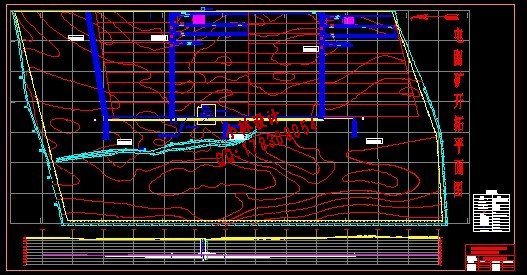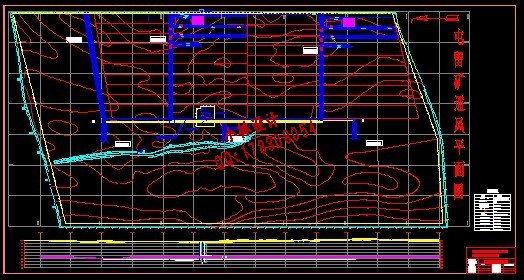 |
 |
|


|
设计名称 |
屯留矿500万t新井通风系统设计[安全工程] |
 |
|
设计编号 |
c186 | |
|
设计软件 |
AutoCAD, Word | |
|
包含内容 |
见右侧图片 | |
|
说明字数 |
56000字 | |
|
图纸数量 |
见右侧图片 | |
|
推荐指数 |
较高 | |
|
价格: |
价格优惠中 | |
|
整理日期 |
2013.09.26 | |
|
整理人 |
小林 | |
|
购买流程 |
<查看如何购买本站设计> |
|
设计简介 |
设计描述: 文档包括: 设计说明书一份,124页,约56000字 CAD版本图纸,共4张 ………………
毕业设计专题题目:煤炭自燃发火规律的研究
毕业设计主要内容和要求:
工艺,矿井通风设计,矿井安全技术措施设计(选择综合防尘措施及洒水、注水系统设计)部分。 发火情况,特别是采空区的发火。采用预防性灌浆等综合治理的办法,有效地制止了煤炭自然发火,并确保
了煤矿的安全生产。 明书条理要清楚,论述充分,文字通顺,符合专业技术用于要求,图纸完备、正确。
摘 要
号煤,平均倾角7°,煤厚平均总厚为6m。
装备箕斗,副井装备罐笼。井田工业储量为758.7Mt,矿井可采储量508.66Mt。矿井服务年限为73a。
用走向长壁后退式采煤法,全部垮落法管理顶板。 ,工作面使用偏“Y”型通风,掘进工作面用局部扇风机压入式通风,根据通风容易、困难时期的最大阻力选
择FBCDZ-8-No.32B型主扇,矿井用反风道反风,主扇及电机选型合理,通风成本较低。 在3~15mm之间,扑灭火焰的岩粉量为5~50%。煤尘均有爆炸危险性。3号煤层属不自燃煤层。本设计将进行综
合防尘措施及洒水、注水系统设计。 火情况,特别是采空区的发火。采用预防性灌浆等综合治理的办法,有效地制止了煤炭自然发火,并确保了 煤矿的安全生产。 关键词:新井设计; 开拓; 采煤; 通风; 安全措施; 注浆防火
ABSTRACT
This design consists of two parts: the general part and the special part.
consists five parts. simpler, The run of the minefield is 13 km ,the width is about 7km,the area is 91㎞2. The three is the main coal seam, and its dip angle is 7 degree. The thickness of the mine is about
6 m in all. the design norms of the Ministry of coal Industry, the mine decides to employ the exploiting method of one levels, the main shaft skip install skip and the auxiliary shaft install cage, the proved reserves of the minefield are 758.7 million tons. The recoverable reserves are
508.66 million tons. its design service life is 73 years. the production capacity. Fully mechanized mining face is 250 m ,six round ships per day. The coal field is divided by six working areas. The coal mining method is ling wall retreating
system on strike. Full-roof-caving method is employed after mining. Tunliu, the designer decides to the determine the breakdown of the ventilation system is used in the mine. The method of splitting air flow quantity is based on calculating from interior to exterior “Y” ventilation system is used in faces, driving faces make use of local fan-in pressure ventilation. according to the ventilation easy, difficult period, the “FBCDZ-8-
No.32B” main fan is selected, reversing turn is applied to reverse air flow. high gas mine. Coal flame length in 3 ~ 15 mm between the fight against the flame of rock powder for 5 to 50 percent. Coal dust explosions are dangerous. On the 3rd coal seam is not spontaneous combustion. This design will carry out comprehensive measures to dust and sprayed
water injection system design. impact of the reasons for the spontaneous combustion of coal analysis, combined with the actual mine ignition, in particular, mined-out area of the ignition. Filling the use of the precautionary approach, such as comprehensive management, effective suppression of the
spontaneous combustion of coal, and to ensure that the coal mine production safety.
一般部分 1 |
|
部分图纸 截图 |
    |
|
说明: |
如需了解本设计的具体详细信息请联系本站客服,说明看哪个设计(编号)哪个详细部分,我们将远程或截图给您观看. 机械毕业设计|论文 |

| [要求PR≥2,百度收录≥1000页;联系QQ:178308054] |
Powered by 小林机械资料商城 © 2013-2020 All Rights Reserved. 客服QQ:178308054
喜欢www.xiaolinbysj.com,请告诉你QQ上的5位好友,多谢您的支持! 皖ICP备2021006205号-1
